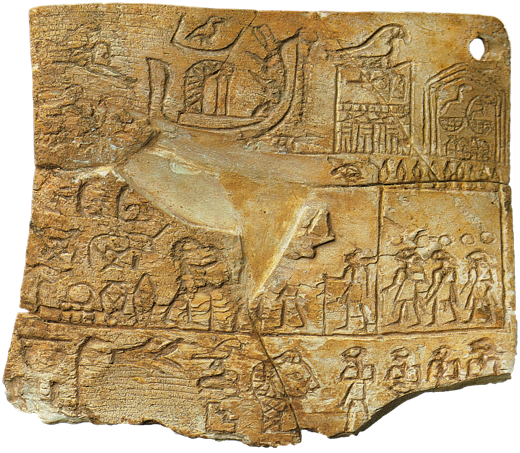Switching our attention now from Narmer, we, now, come to a man called Hor-Aha. His name means Warrior or Soldier of Horus and he was the second pharaoh of the First Dynasty. His name may also be associated with Menes (more on him later) about whom Egyptologists know very little other than founding the capital of the Old Kingdom, Memphis or Men-nefer (Enduring and Beautiful). In the following paragraphs, details of Hor-Aha's life and tomb, how do we know that Hor-Aha existed and finally how little is known concerning the First Dynasty.
 |
| Serekh of Hor-Aha courtesy of Wikipedia |
There is a matter of some debate that Hor-Aha may have actually been the ephemeral pharaoh, Menes which would greatly enhance the status of Hor-Aha because he would be credited with the foundation of Men-nefer as stated above. What makes this theory interesting is the figure of Neith-hotep who may have been his mother if Hor-Aha is, indeed, Menes. According to this theory, then, Hor-Aha would be the successor and son of Narmer and Neithhotep (his mother) whom we mentioned in the last blog as the founder of the First Dynasty and who is credited with the unification of Upper and Lower Egypt. According to the Palermo Stone, the reign of Hor-Aha was only 7 years and he did have a wife called Khentkap. The Palermo Stone also mentions three other names who may have been sons of his because titles and land were only inherited by family members. His reign did include visits to temples and shrines like succeeding pharaohs of the Old Kingdoms (a precedent?), it is interesting to his tomb is the oldest in the Memphite necropolis which has also led some Egyptologists to believe that he was the founder of the capital, Memphis. Of course like other succeeding pharaohs as well, he did conduct military campaigns (probably the first Thof the kind) into Nubia and his name has even been found in Syria-Palestine where he gained a foothold in trade in the area. But how do we, in fact, know about the First Dynasty with so little information and artefacts? Is this all just speculation?
 |
The Naqada Label courtesy of egyptopia.com
|
When we actually compare the First Dynasty with the succeeding dynasties of Egypt, it is the one shrouded most in mystery. Although, Archaeologists have discovered tombs like that of Hor-Aha, they do present difficulty producing a narrative of some sort to piece together the lives of those pharaohs of not just the First Dynasty but the Old Kingdom in general. Taking Hor-Aha as an example, his name is found in several pieces of artefacts not only found in Egypt but in Syria-Palestine and Nubia as well. His name is also mentioned on the Naqada Label. This is particularly noteworthy for Egyptologists is because the Naqada Label not only has his Horus name but also his Nebti name which is Menes which does elicit some explanation on the part of Egyptologists on just who are these figures Menes and Hor-Aha. Are they the same person or is Hor-Aha and if they are the same person are they, then in turn, the son of Narmer and Neithhotep? This brings us back to the beginning however. With so little evidence and artefacts, this presents a problem for Egyptologists to paint a conclusive picture of these seemingly ephemeral figures in Ancient Egyptian history.
 |
| Tomb of Hor-Aha courtesy of AncientEgypt 101 |
It must be understood though that the First Dynasty is one that is hidden behind a curtain and until Egyptologists can open the curtains, the picture of the First Dynasty will still be hidden. There is good news however. With artefacts such as the Palermo Stone, the Naqada Label and tombs like Hor-Aha's do provide us a glimpse of this First Dynasty of Egypt. In the previous blog, we discussed Narmer and his attempt to unite Upper and Lower Egypt probably through violence. The Narmer Palette, the Battlefield Palette and the Narmer Macehead, all give us vital information into how the Twin Kingdoms were united. All three point to a violent unification resulting in Upper Egypt conquering Lower Egypt thereby establishing Narmer as the founder of the First Dynasty. It seems though, with the violent unification of Upper and Lower Egypt, that Hor-Aha continued to spread Egyptian influence and power not only in Nubia but in Syria-Palestine where his name has been found. It lends support and credit to the theory of unification through violence if Hor-Aha also extends already said influence south and north.
 |
| Narmer Macehead courtesy of ancientegyptonline.co.uk |
In conclusion, although the First Dynasty is shrouded in fog given so little evidence of artefacts, names and tombs, Egyptologists have been able to still paint a picture of the First Dynasty albeit not so clear. Hor-Aha, the second pharaoh of this dynasty may also be the ephemeral Menes as well who is credited with the foundation of Men-nefer. It also seems likely that if Narmer were his predecessor that Hor-Aha would continue violence into Nubia and securing trade and trade routes in Syria-Palestine which would further fill the coffers of the Ancient Egyptian treasury. Although there is little evidence of the First Dynasty, it is extremely interesting that artefacts such as Battlefield Palette, the Narmer Palette and the Narmer Macehead all point to a unification through violence which would lead us to believe that Hor-Aha was continuing what his father, Narmer, did. So tell me what you think! Are Hor-Aha and Menes the same person? Was the conquering attitude of Hor-Aha merely a continuation of his father, Narmer, who, through violence united Upper and Lower Egypt or is it just a coincidence? Please leave a comments, questions and feedback
References
http://www.ancient-egypt.org/history/early-dynastic-period/1st-dynasty/horus-aha/biography-of-horus-aha.html
http://www.ancient-egypt.org/_v3d/index.html



No comments:
Post a Comment